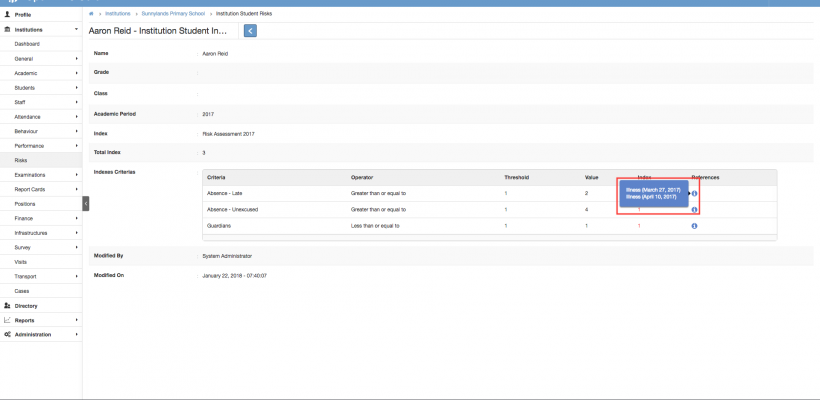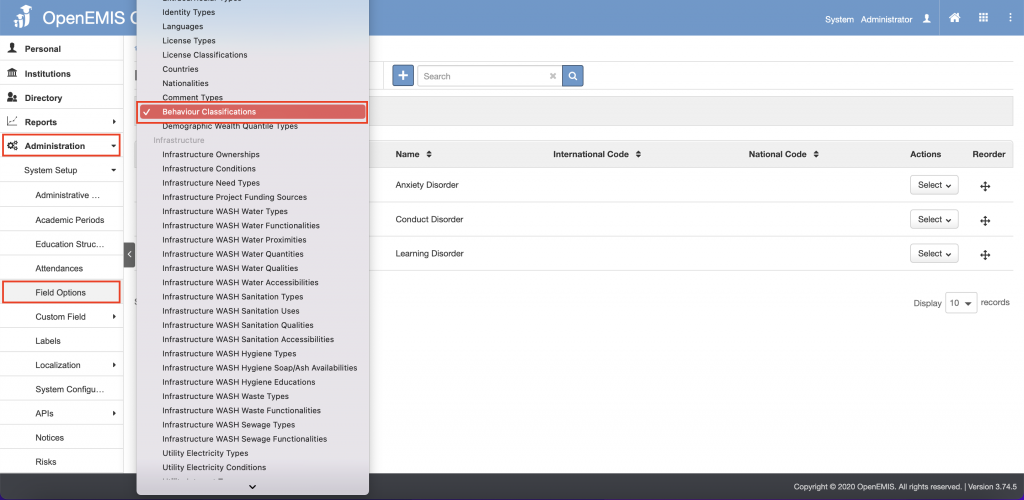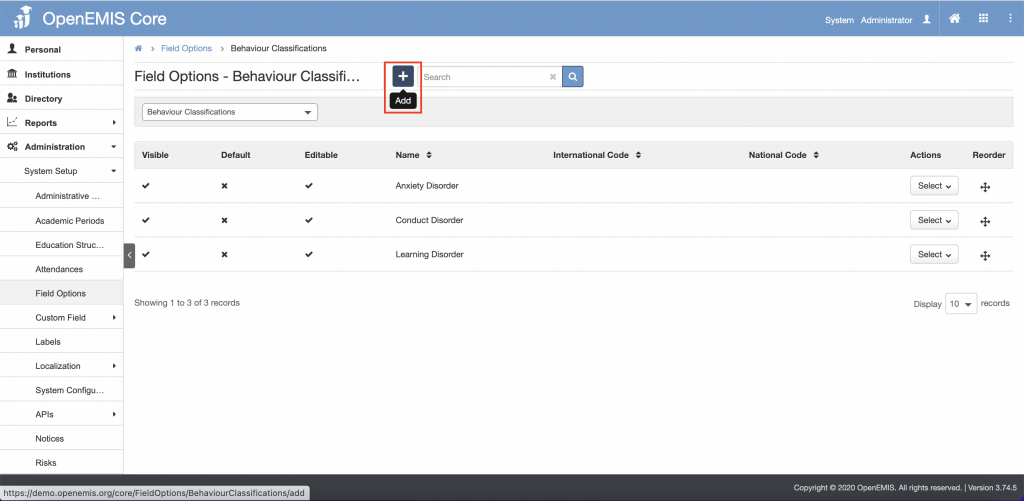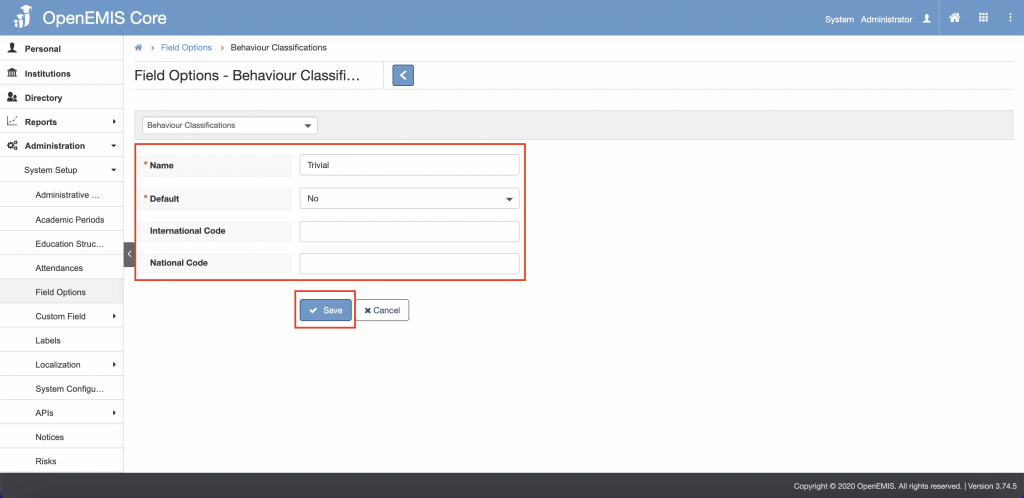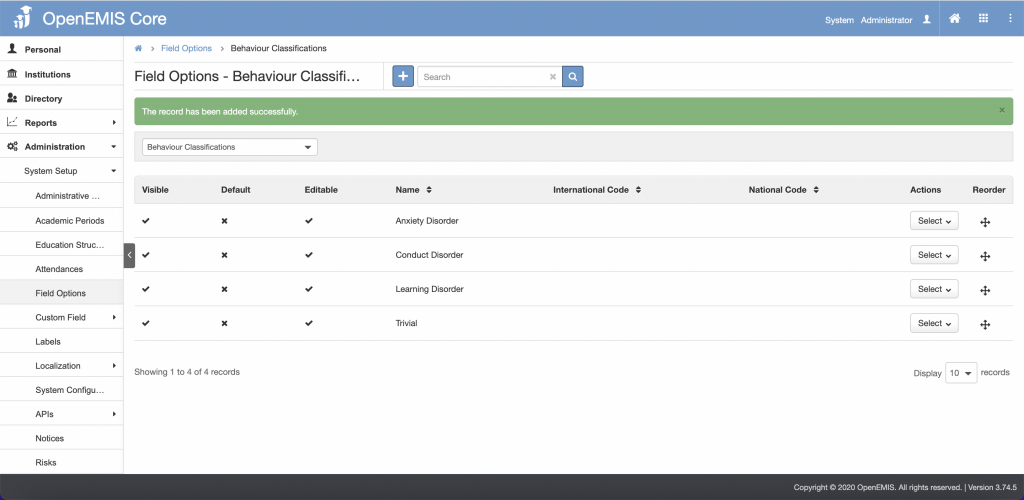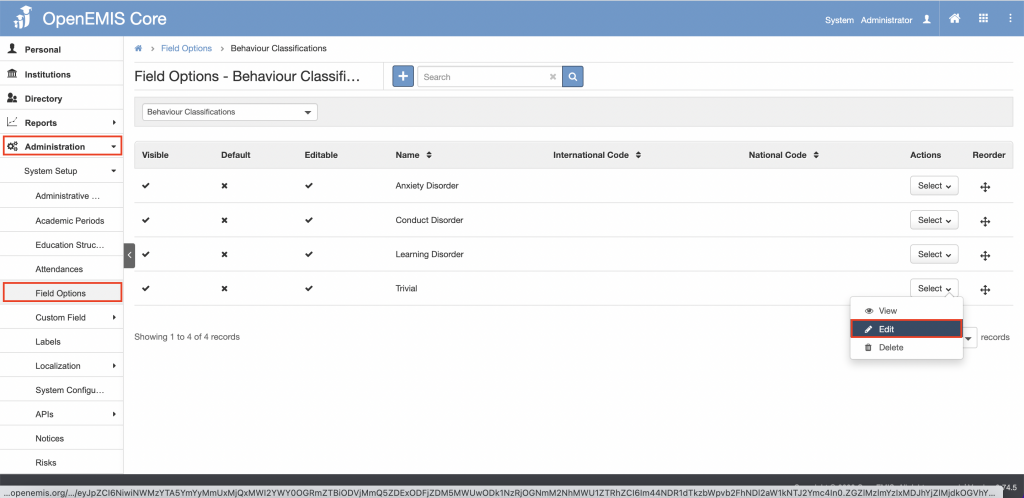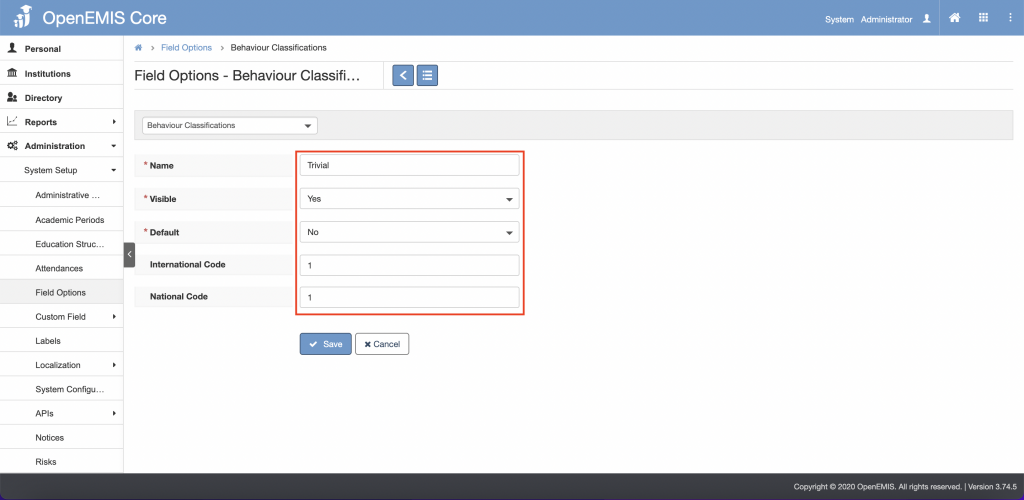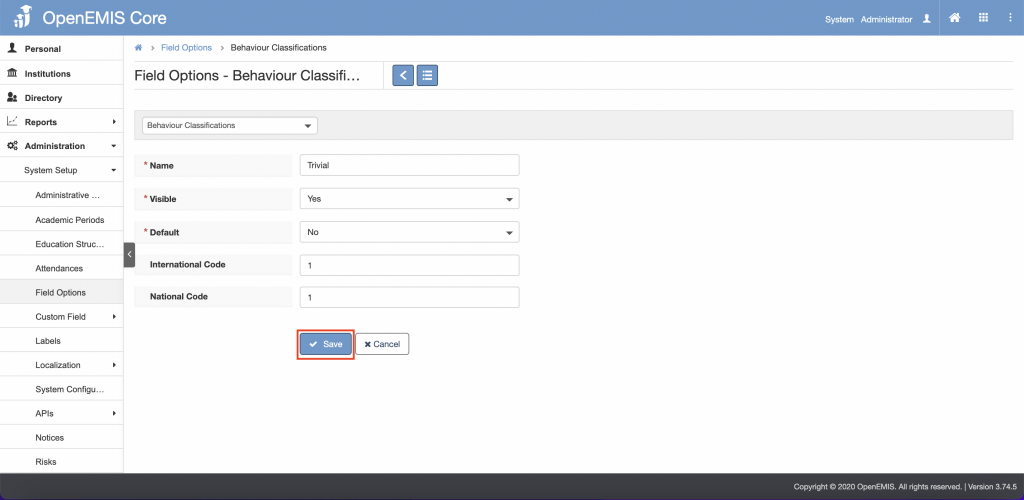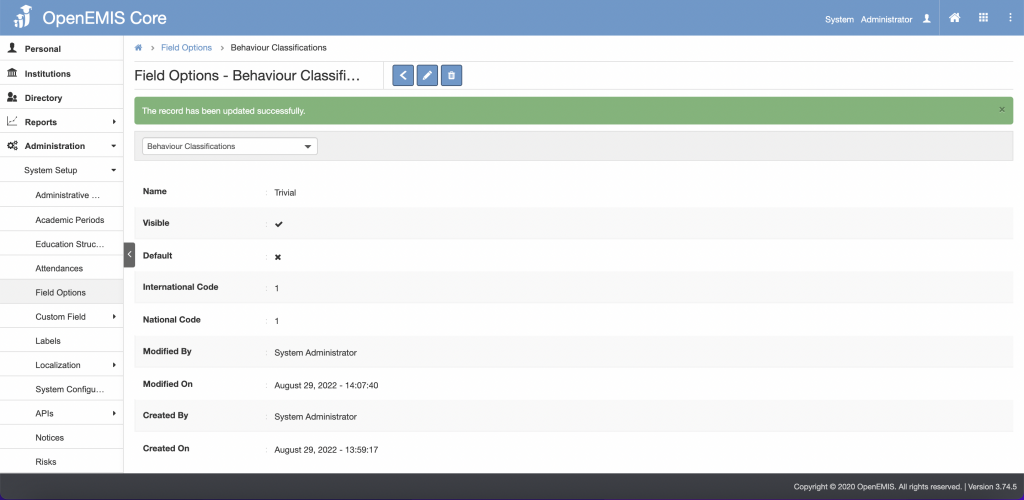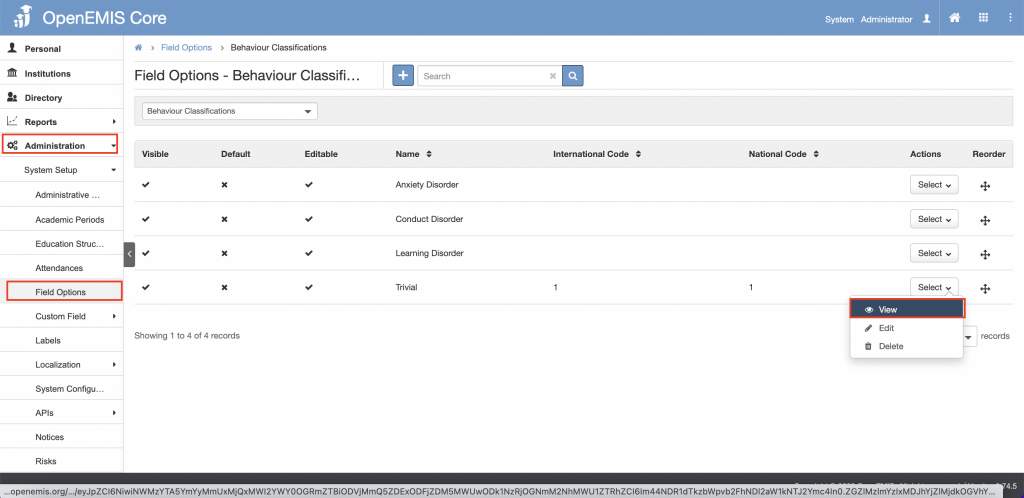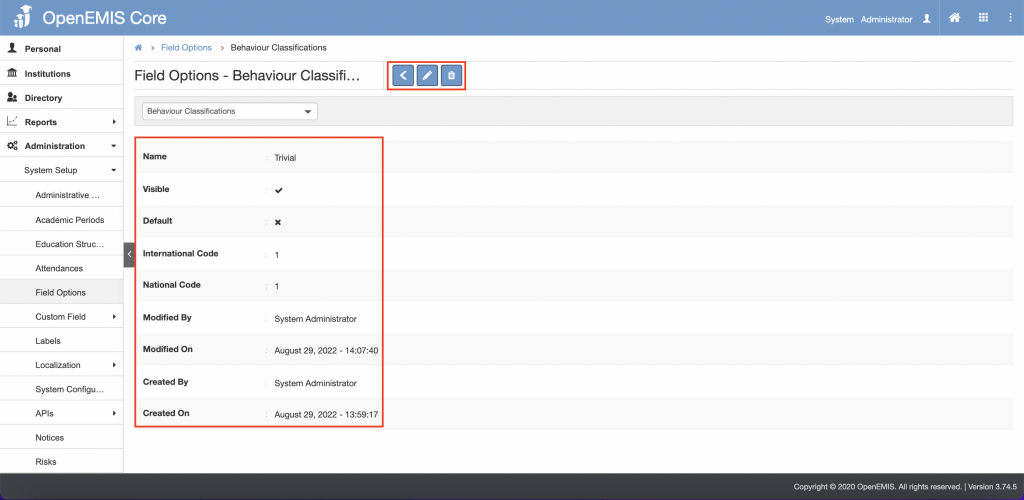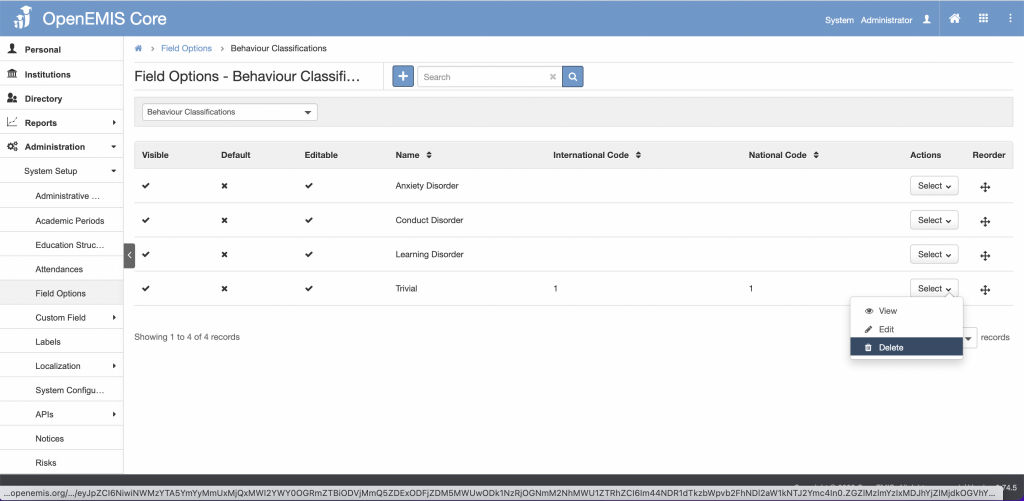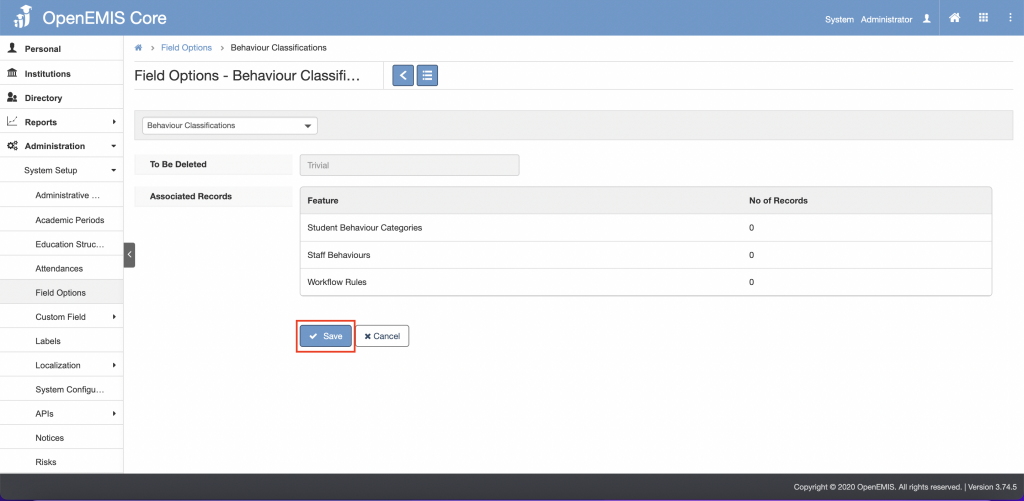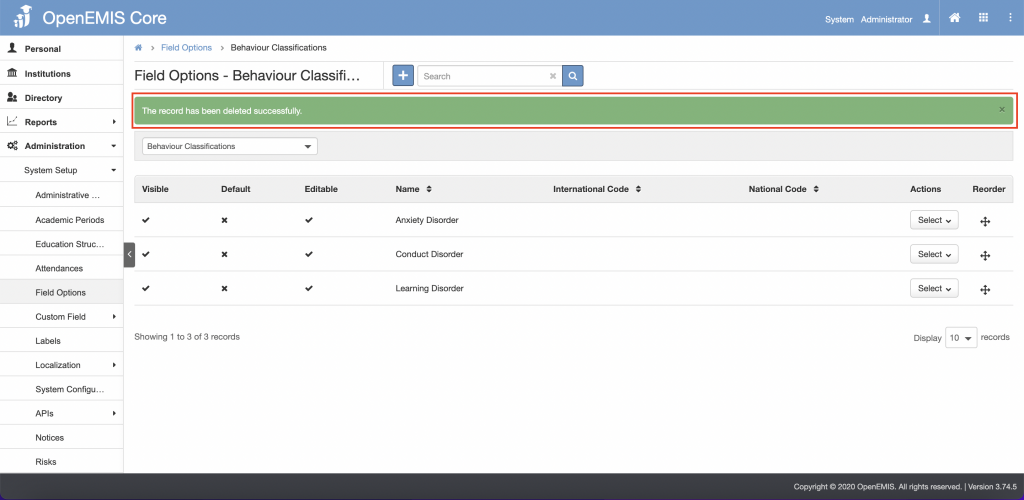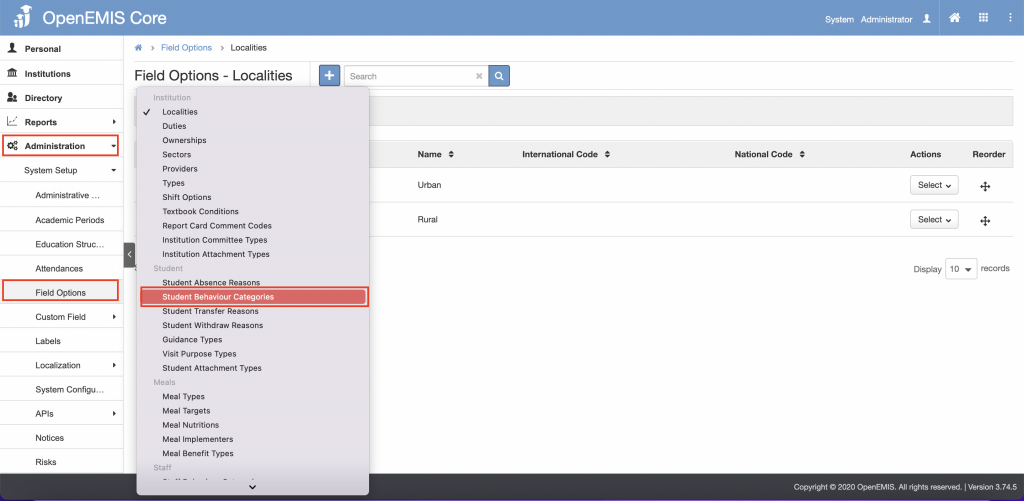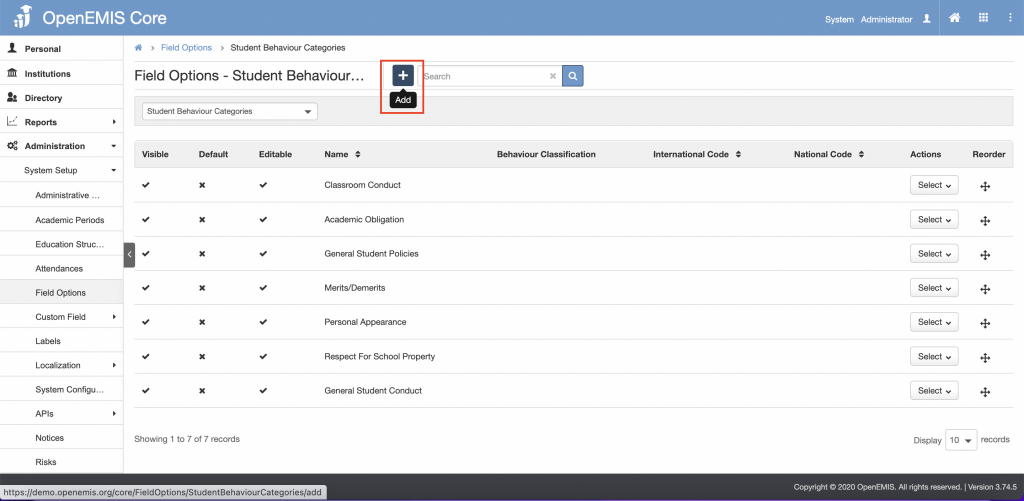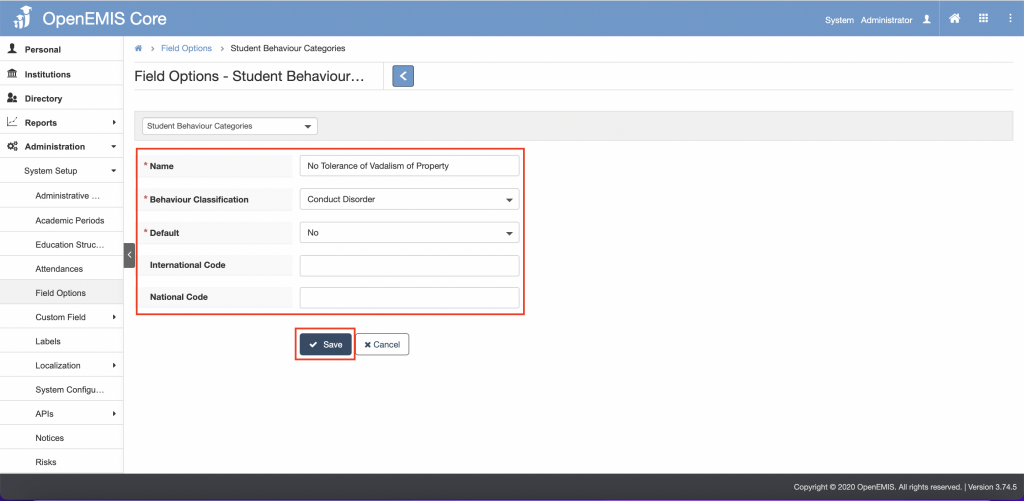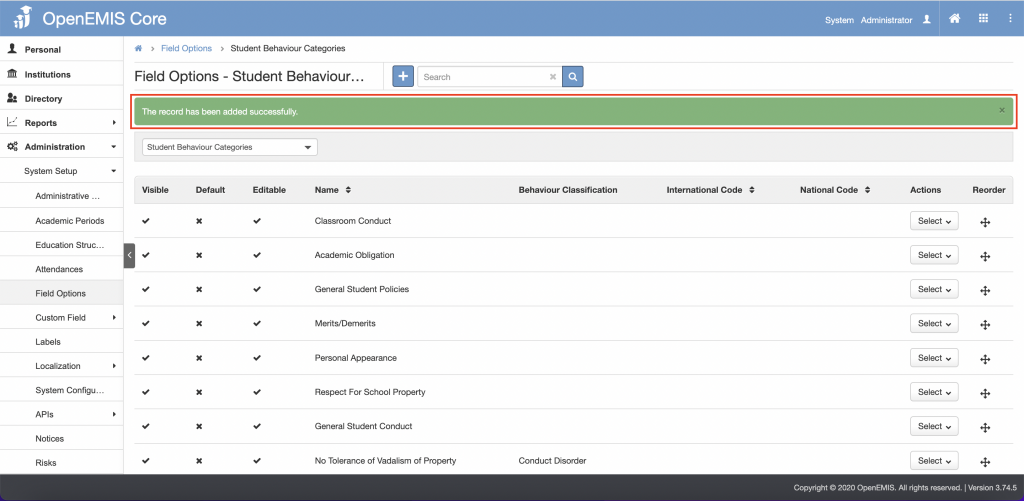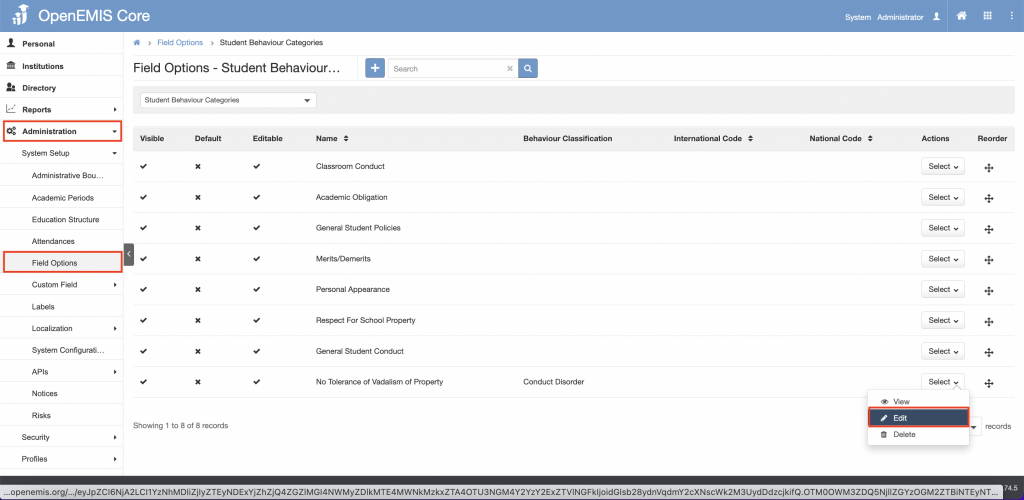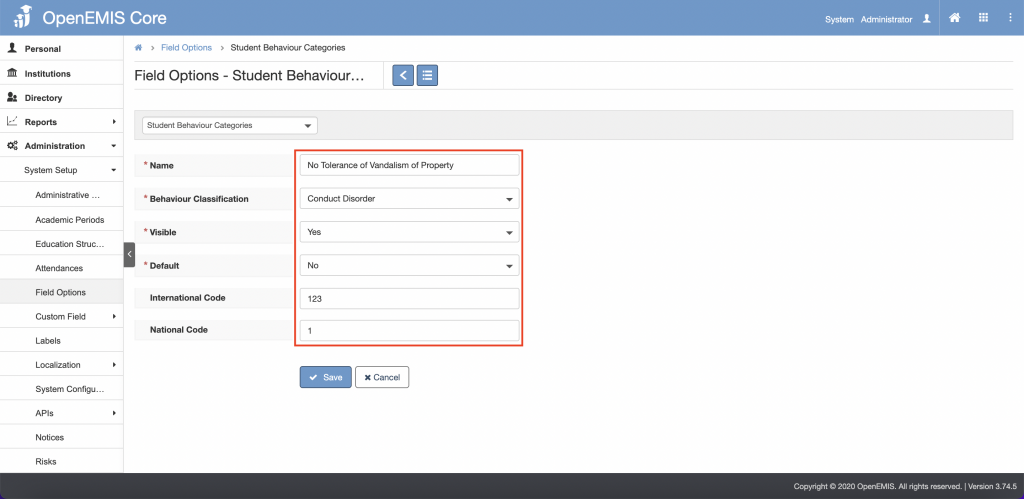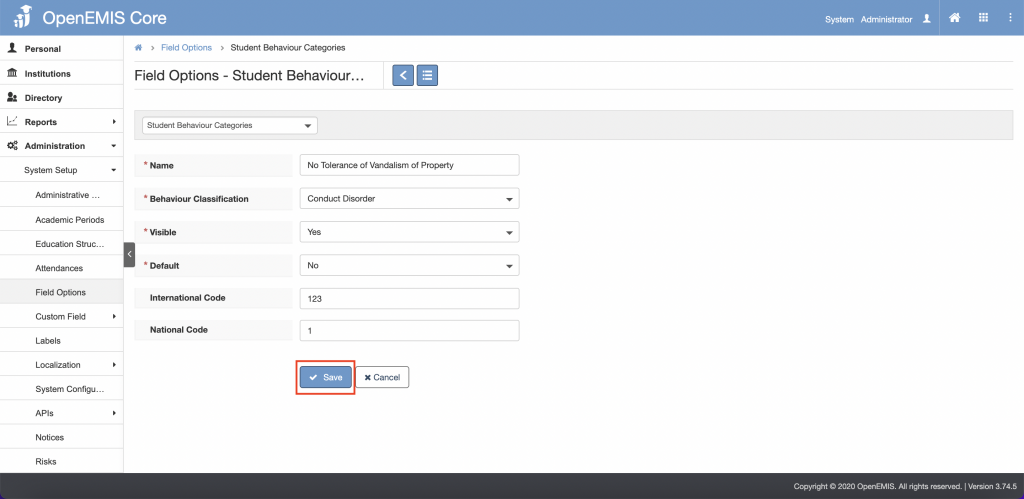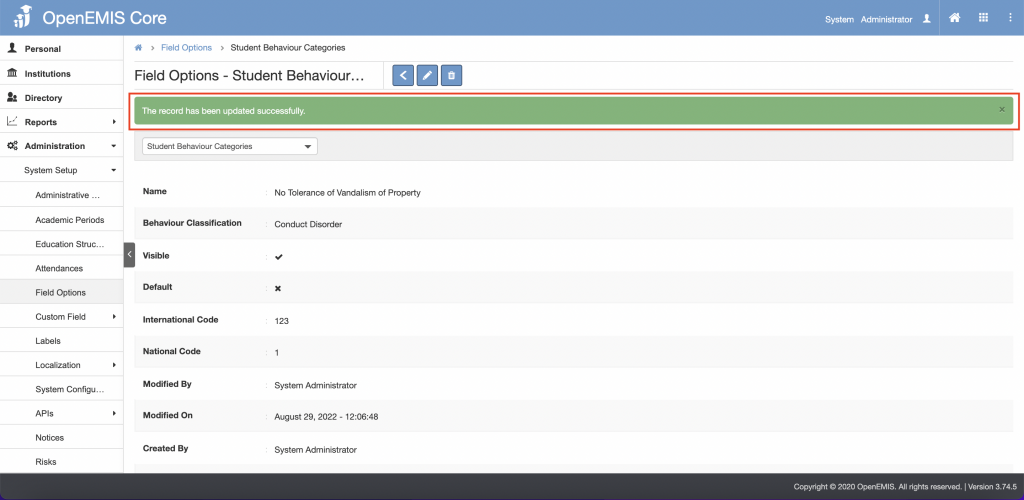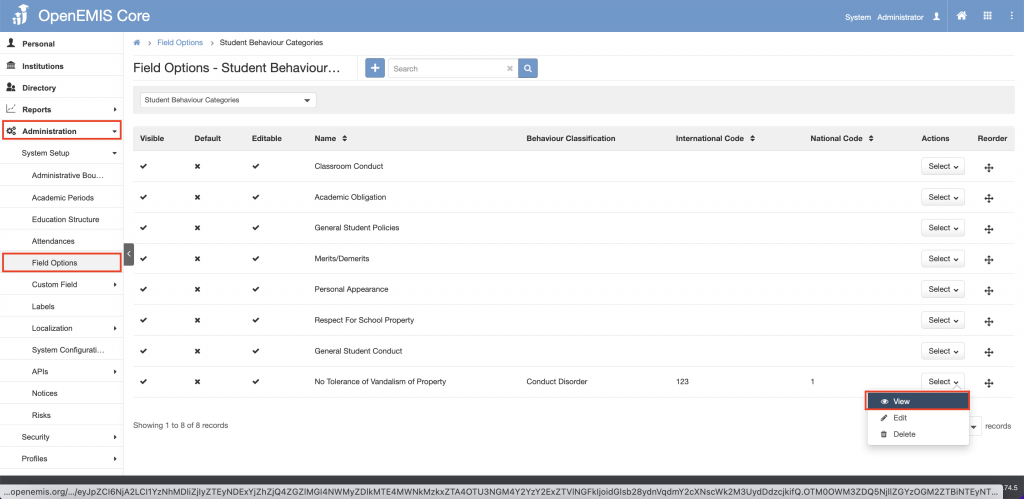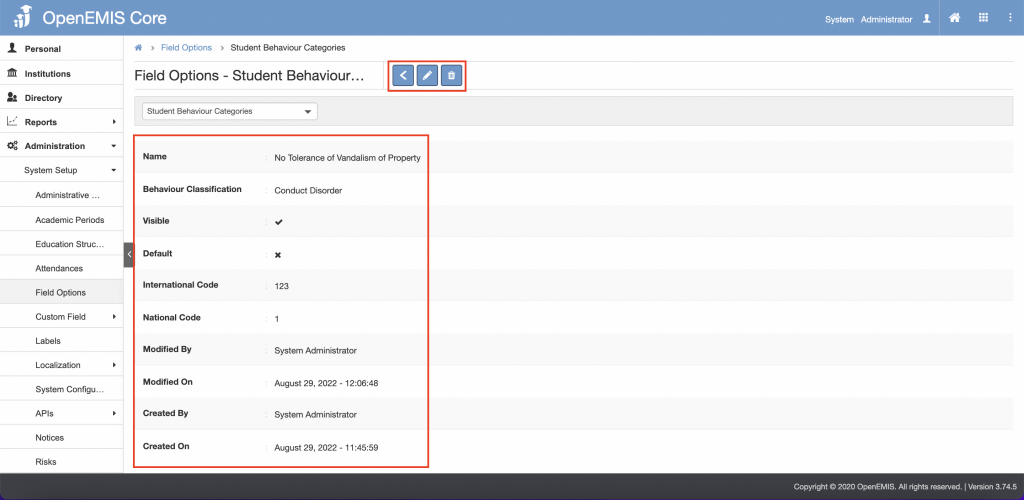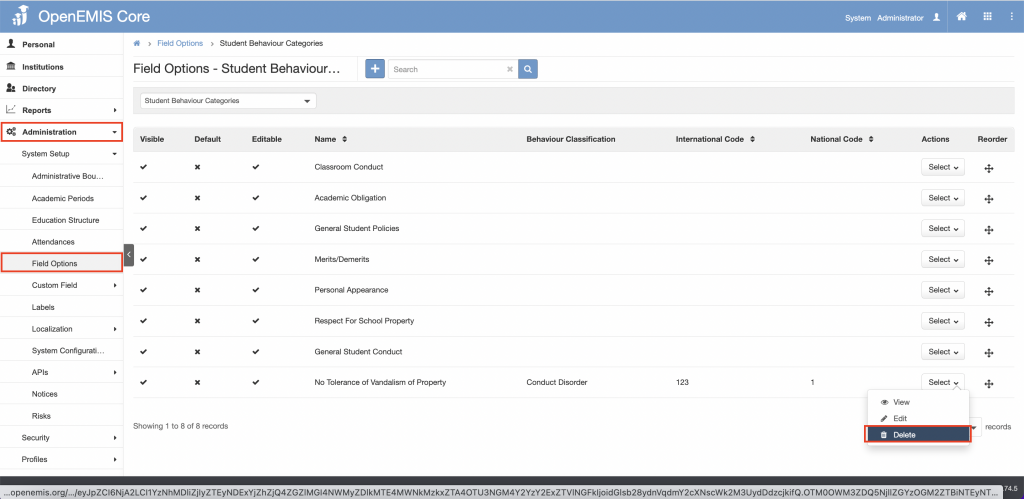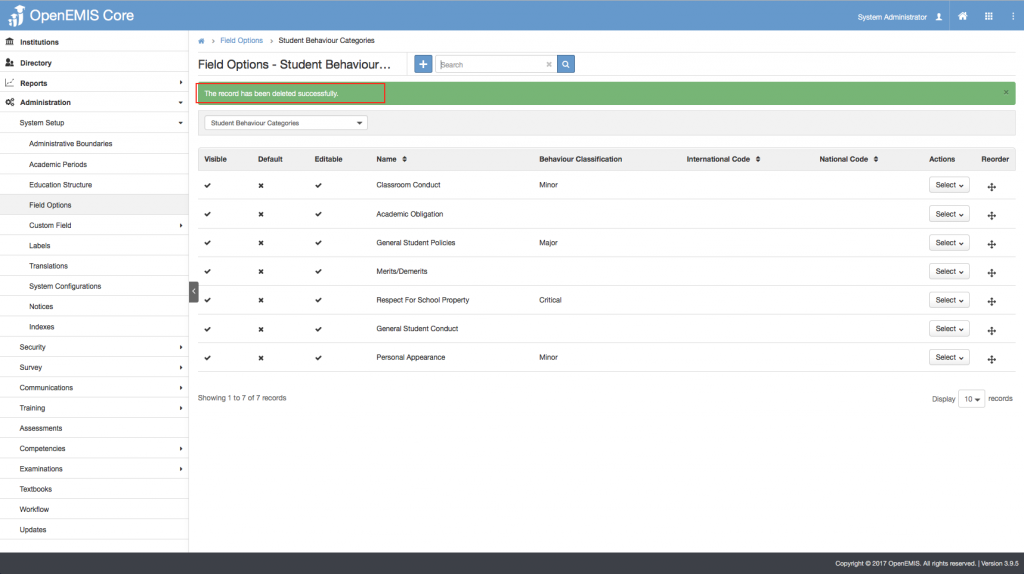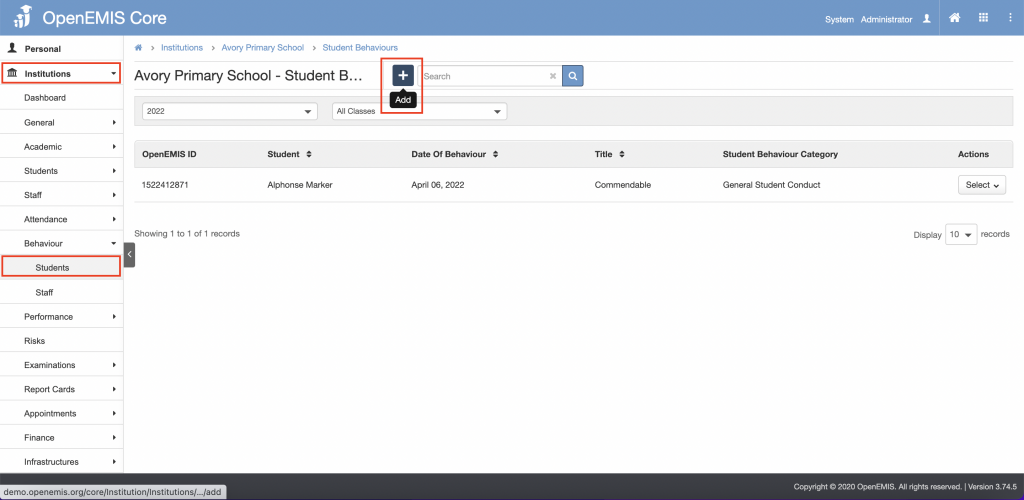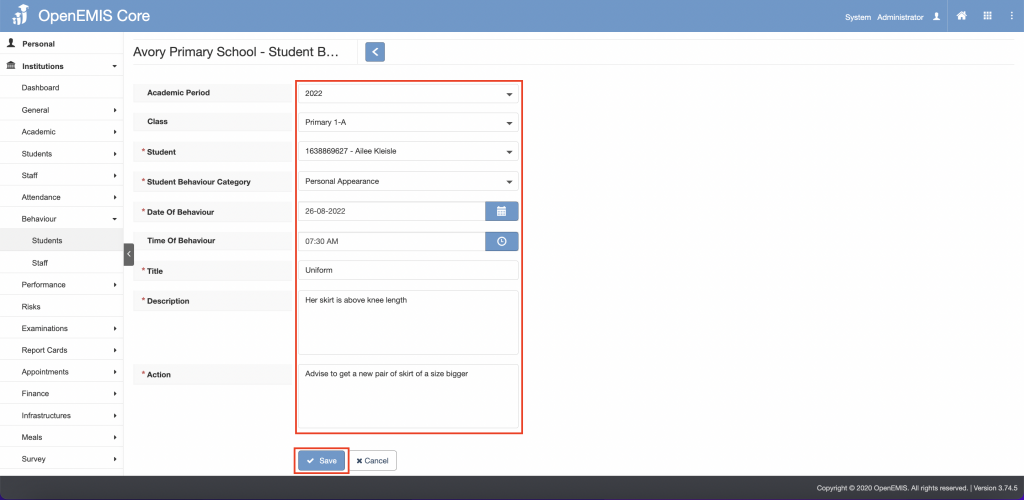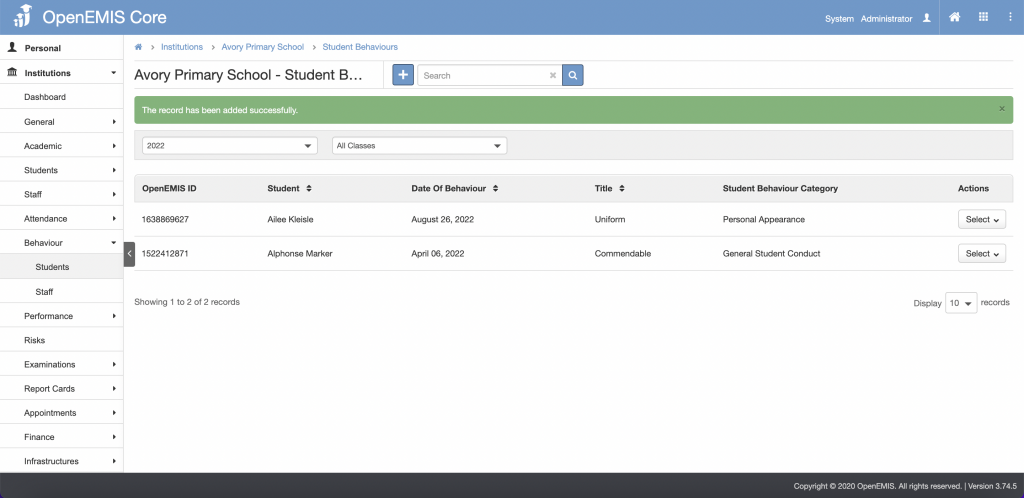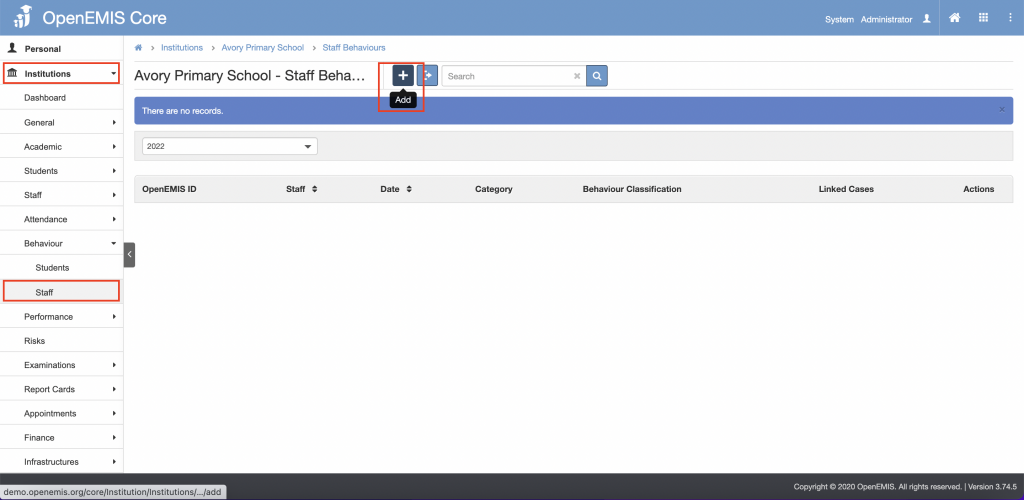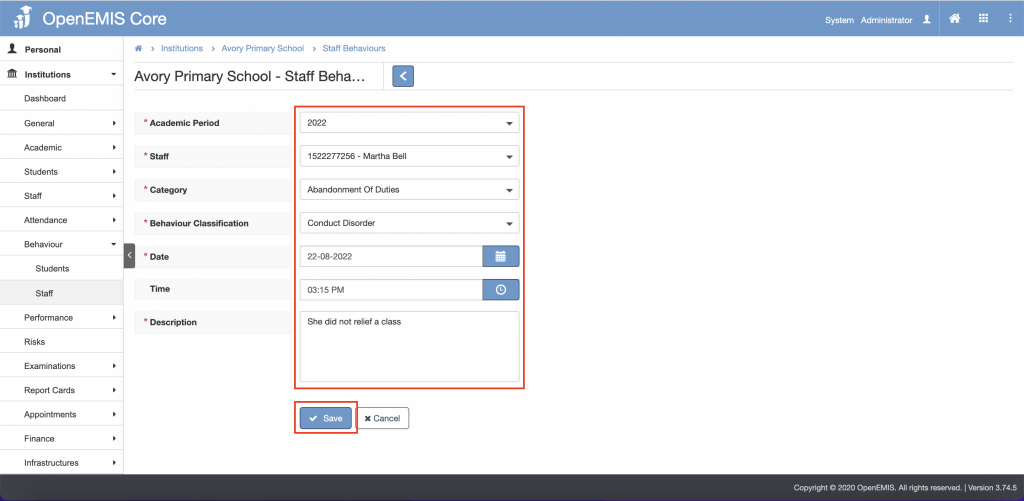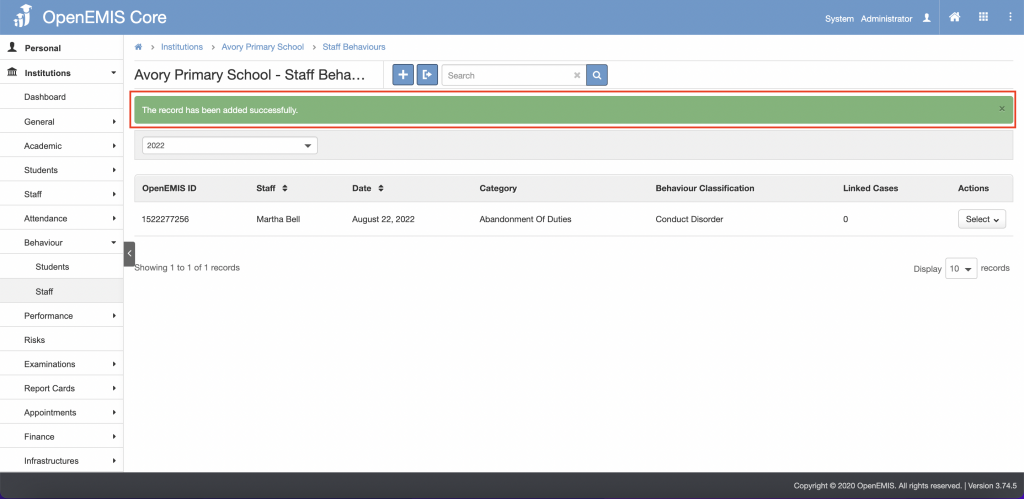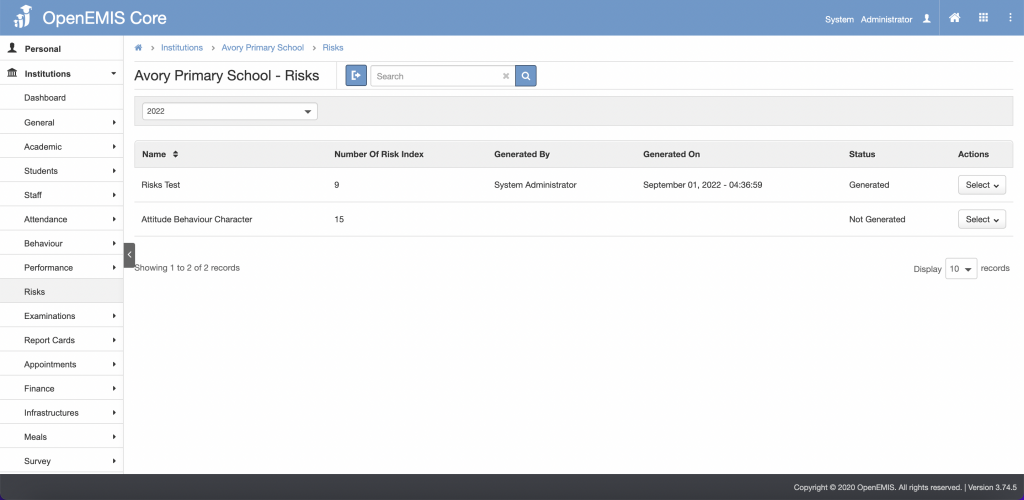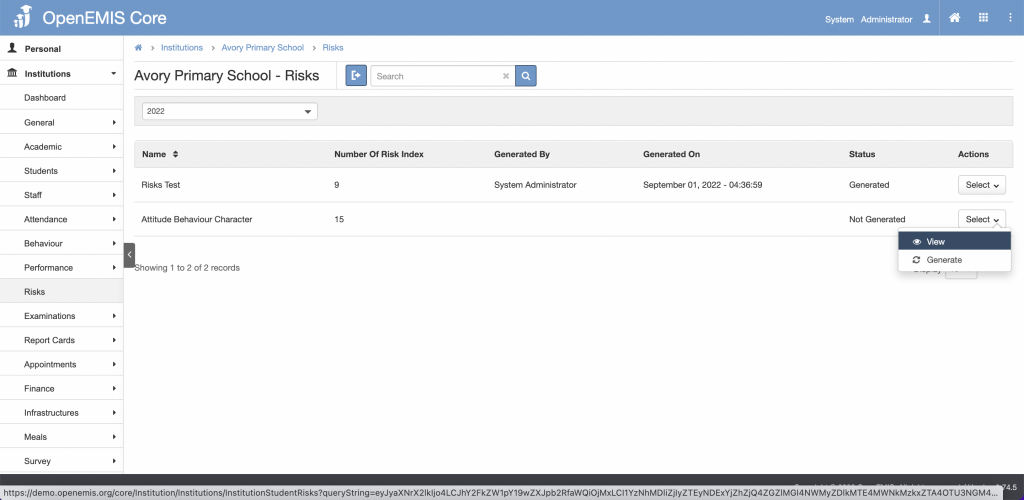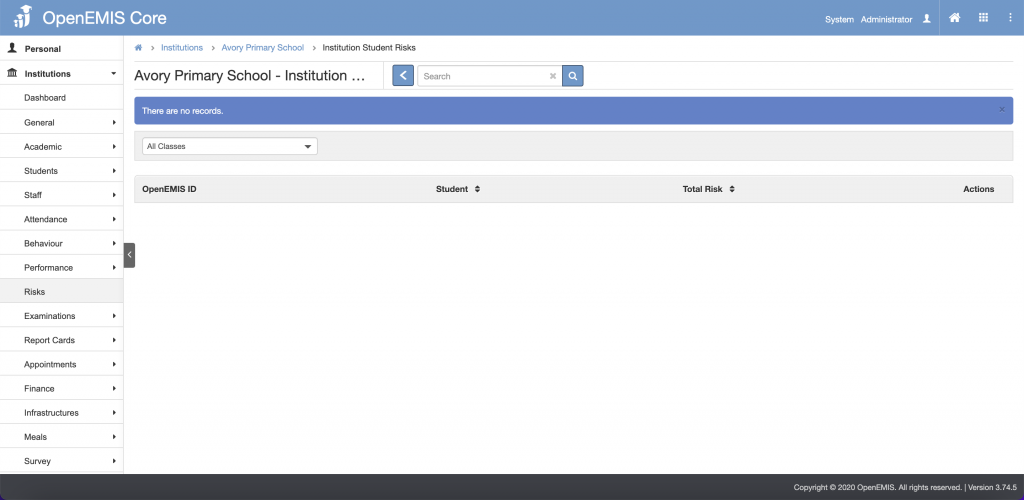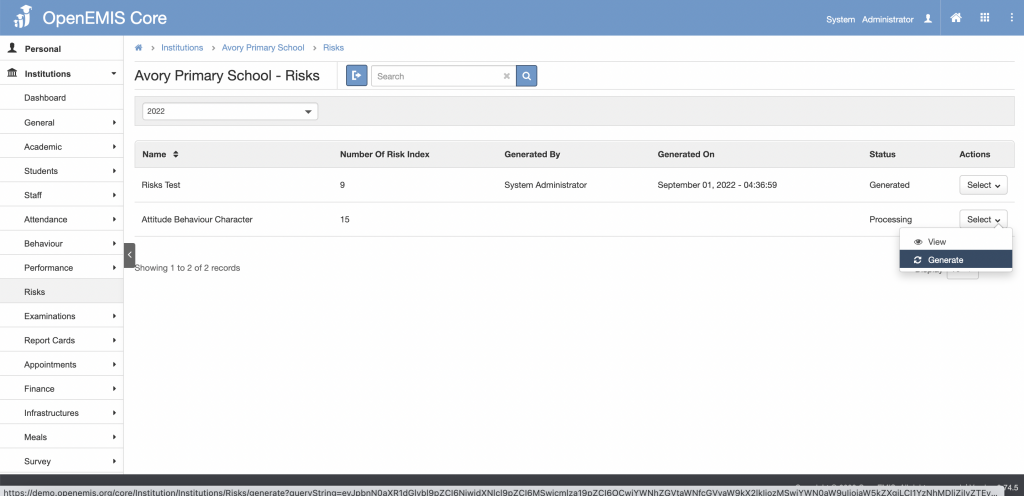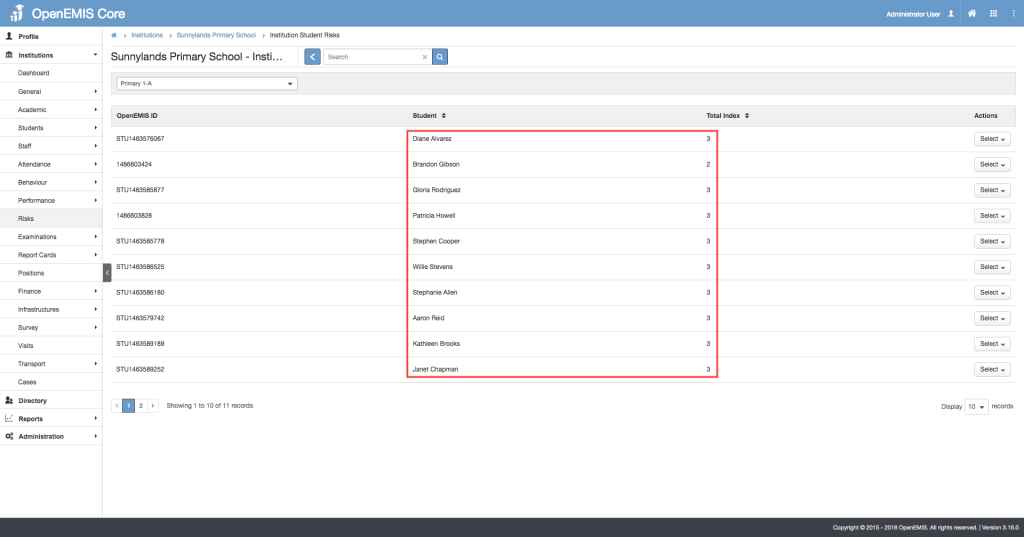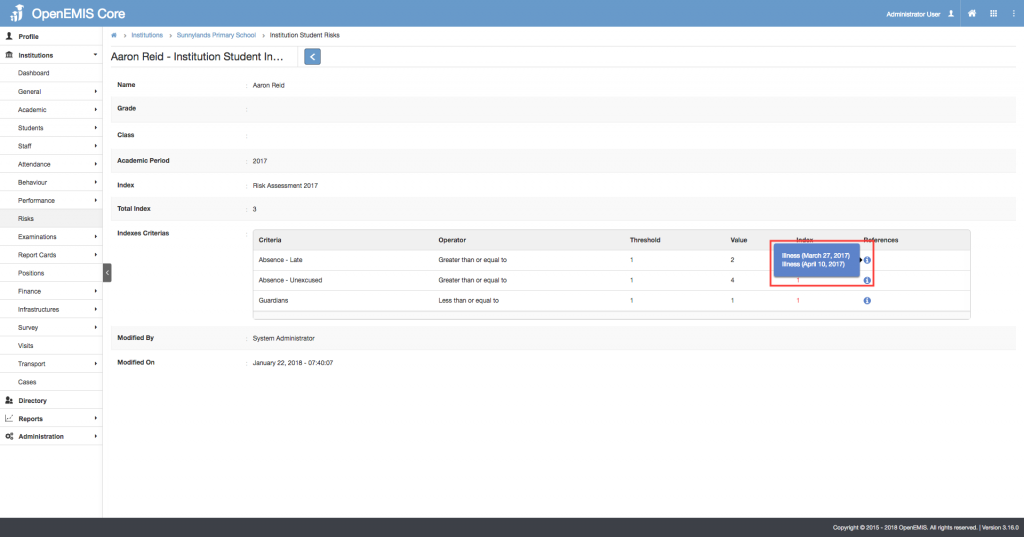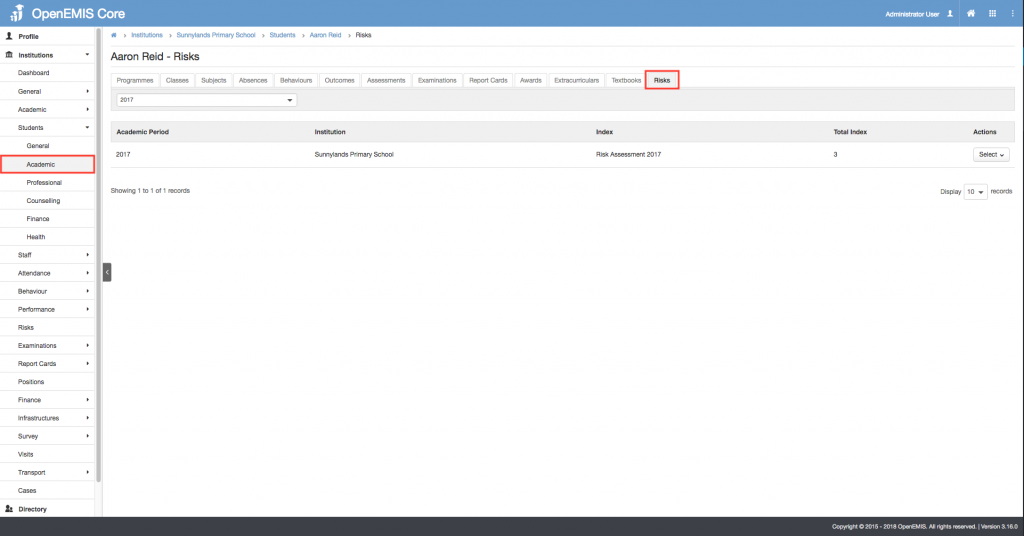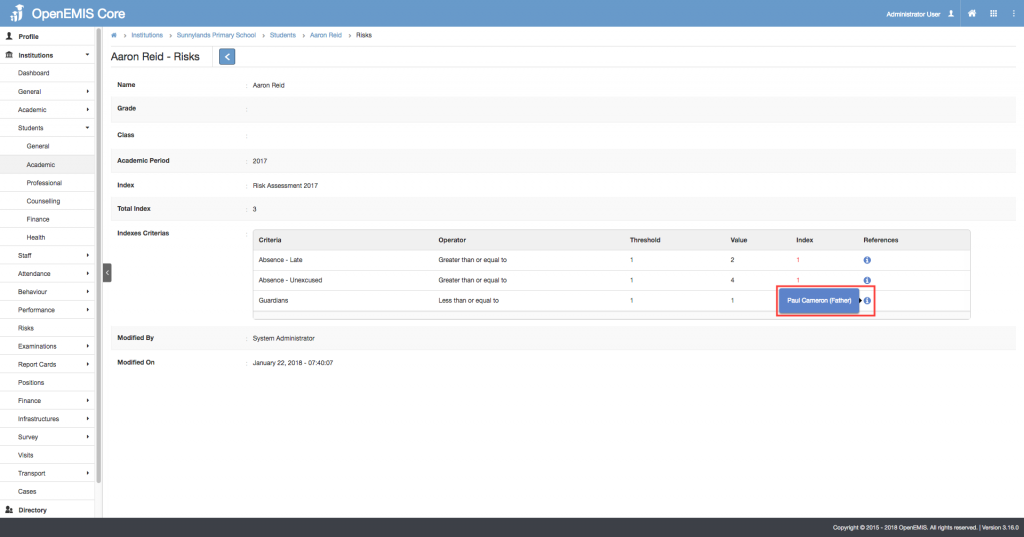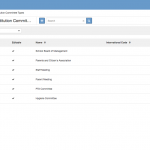Article Name: Risks
Category/Module: Administration, Institution
Tags: Risks
Version: 3.74.5
Date Updated: 29 Mar 2022
This Risks feature will allow you to monitor students at risk of dropping out of school with an early warning system to help children in need in a timely and efficient manner. User would be able to configure and customize indicators to determine dropout risk based on available student information from OpenEMIS Core. E.g. Absenteeism.
- Managing Risks (Administration)
- Managing Behaviour Classifications (Administration)
- Managing Student Behaviour Categories (Administration)
- Institution Students Behaviour (Institution)
- Institution Staff Behaviour (Institution)
- Institution Students Risks (Institution)
Managing Risks
Risks Categories
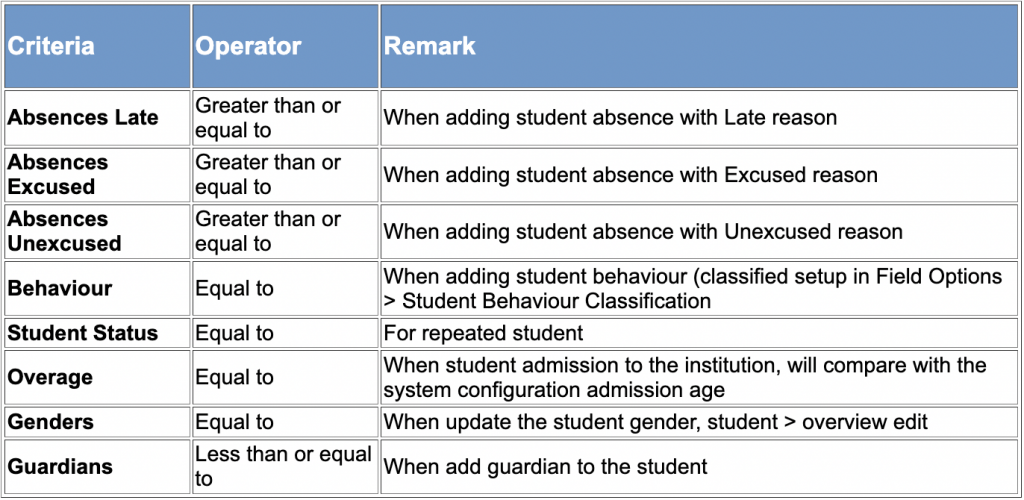
Create Risks
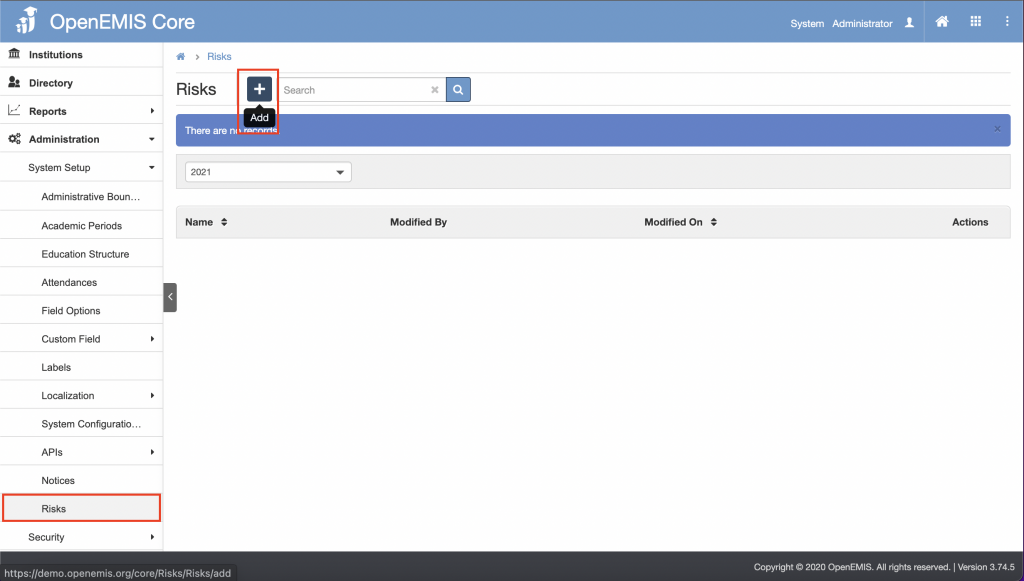
1) Go to Administration > System Setup > Risks
2) Select ‘Add’ button
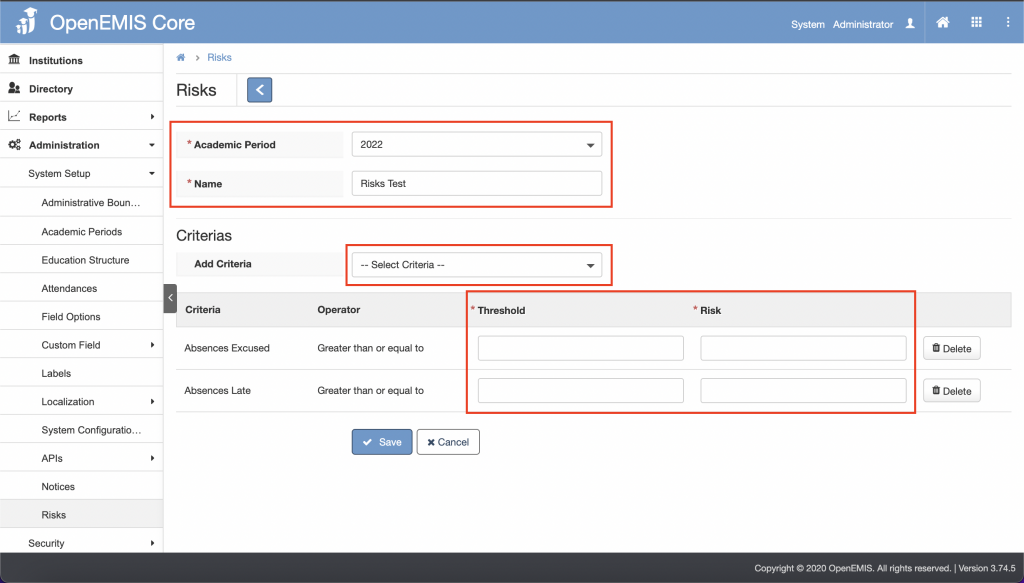
3) Enter the required fields e.g Academic Period, Name.
4) Select on the Criteria option you would like to determine for the student.
5) Enter the Threshold and Risk value for the respective Criteria.
6) Select Save. (Risks name should be unique)
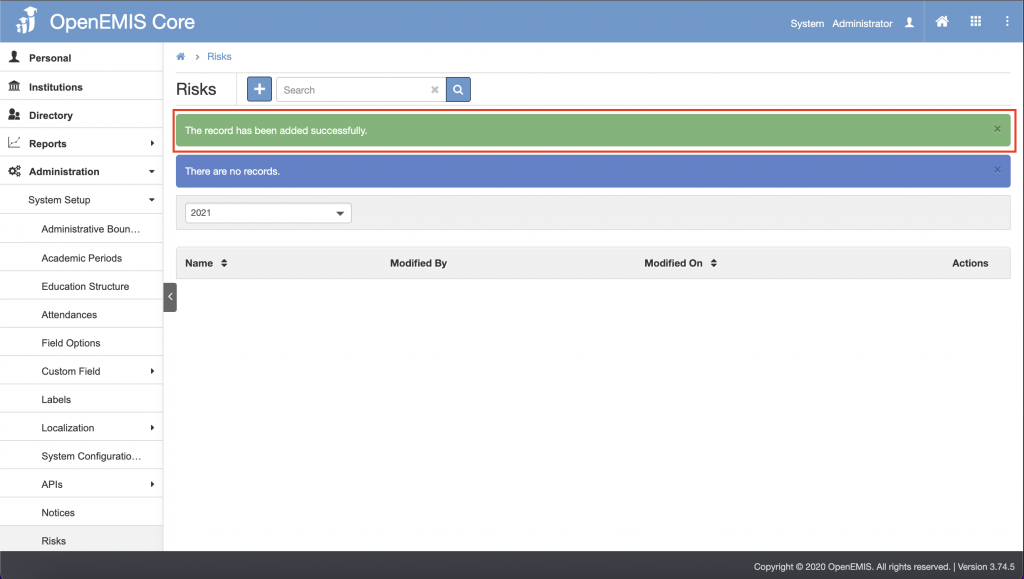
7) System will display a successful message once created.
Edit Risks
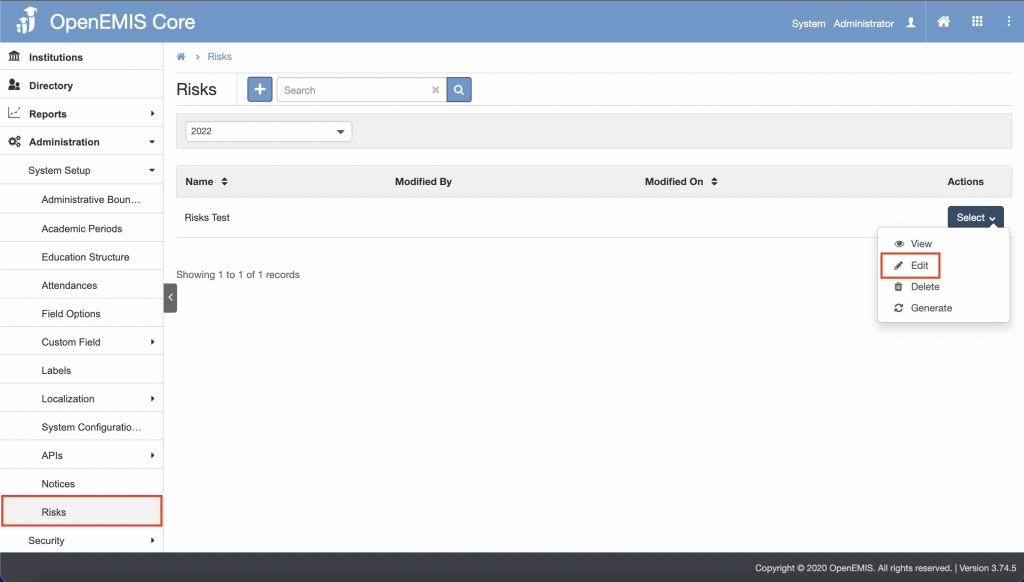
1) Go to Administration > System Setup > Risks
2) You will see a list of records of Risks.
3) Go to Action Bar > Edit
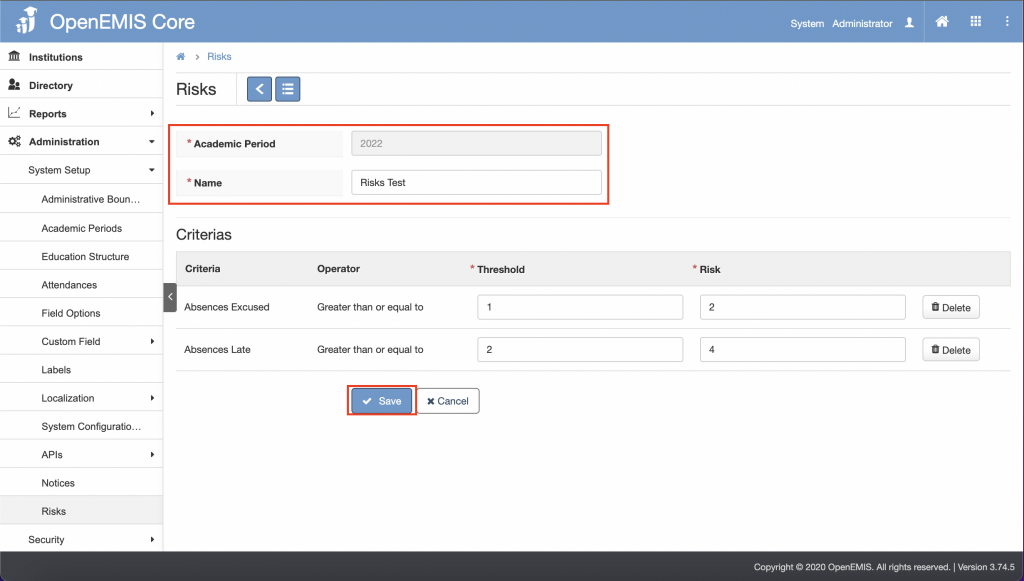
4) You will only be able to edit the Name, Threshold and Risk. You may also choose to remove the criteria from the Risks.
5) Select Save.
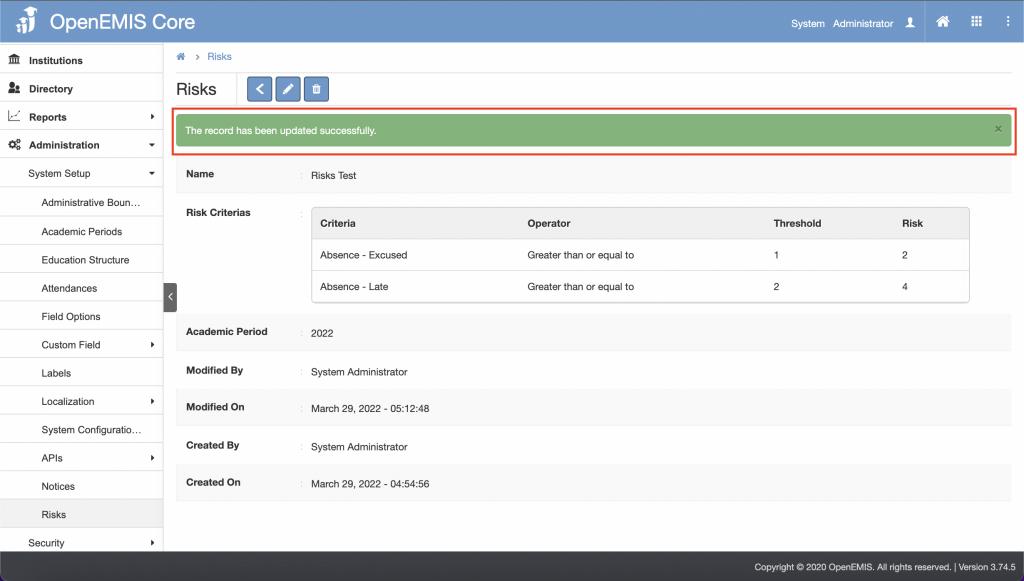
6) System will re-calculate the total risks of the student and display a successful message once created.
View Risks
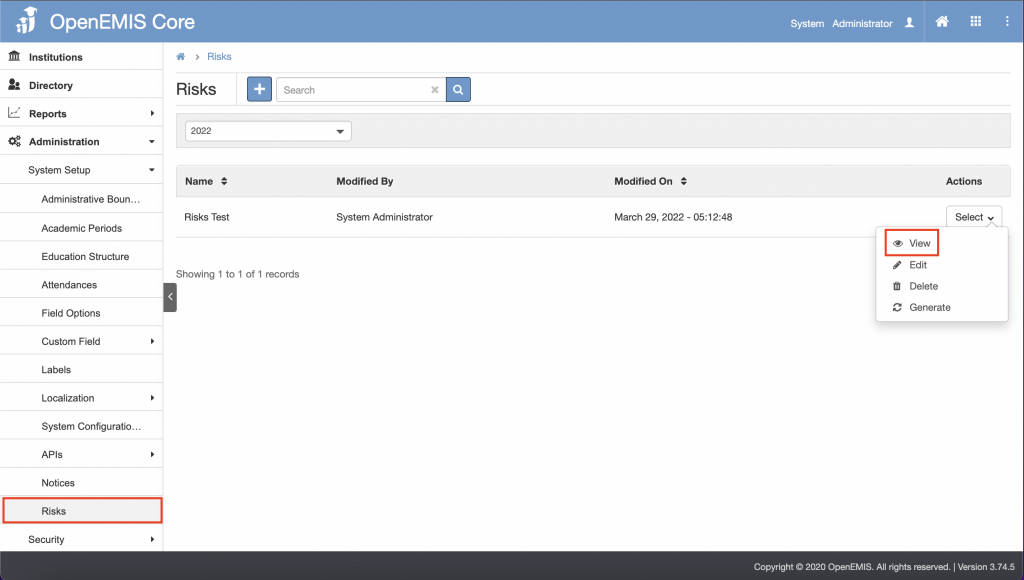
1) Go to Administration > System Setup > Risks
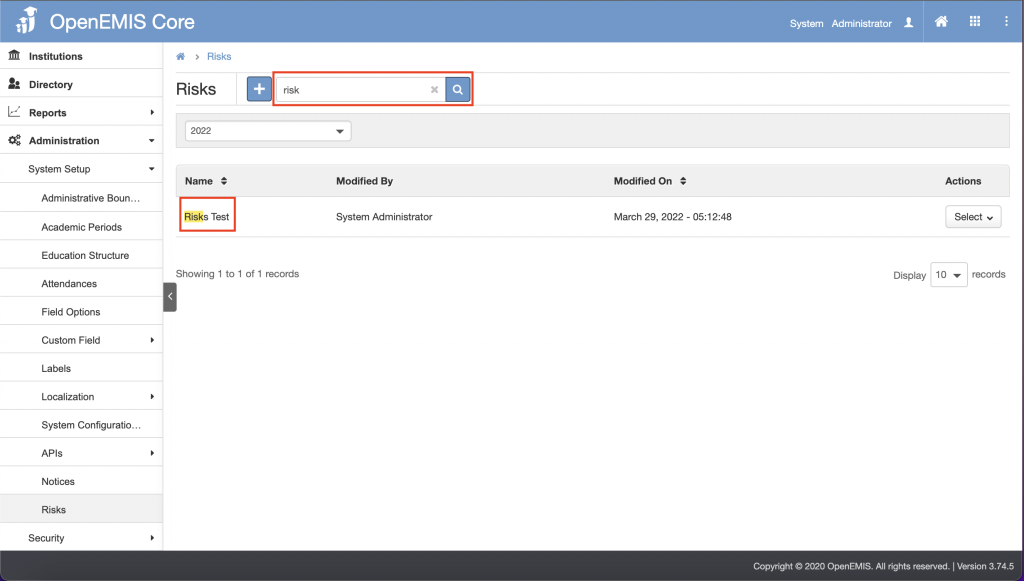
2) You would be able to search/sort for the name of the Criteria based on the Academic Period.
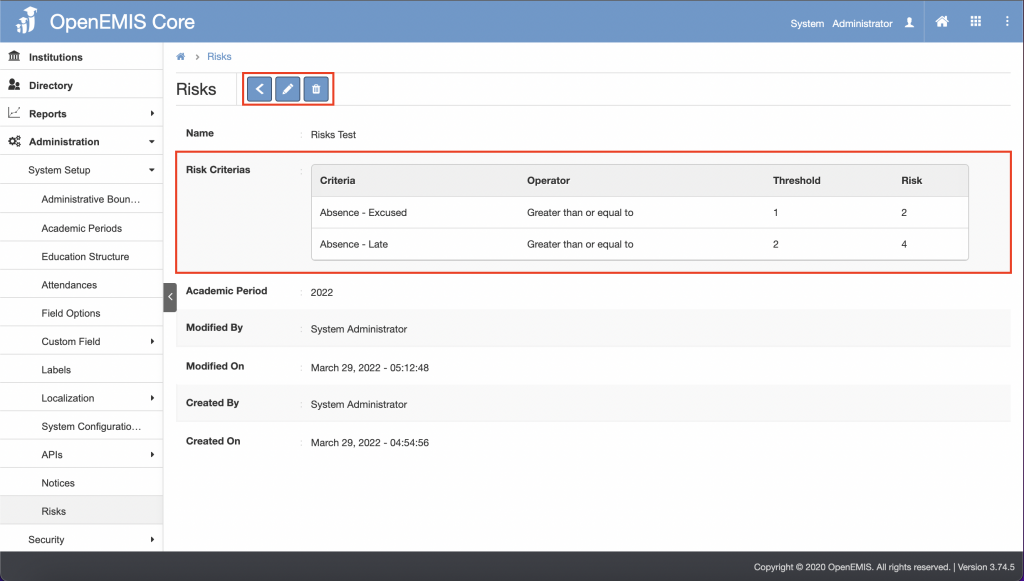
3) You will be able to view additional details of the Risks record.
4) Similarly, you can edit or delete the record in the page.
Delete Risks
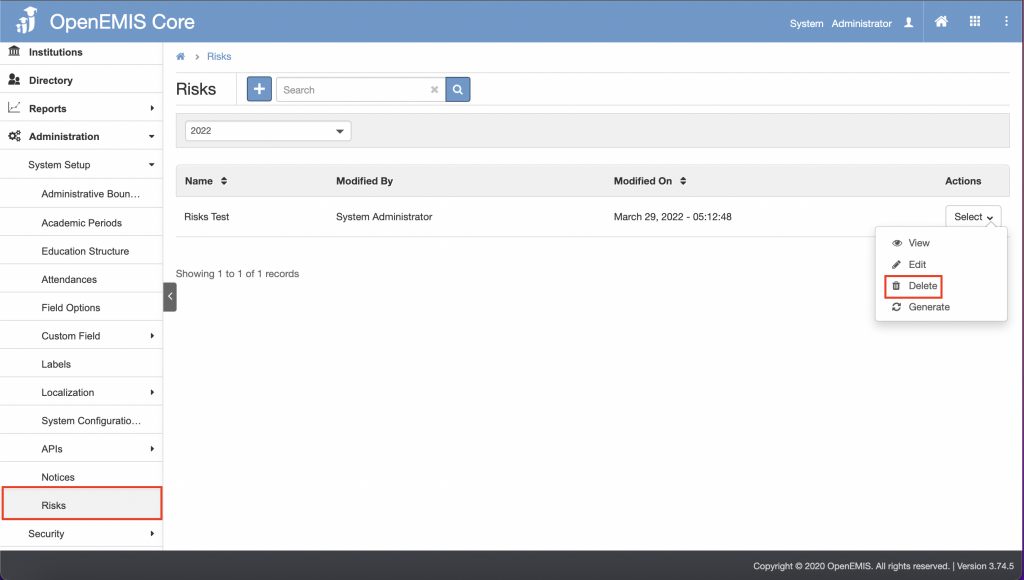
1) Go to Administration > System Setup > Risks
2) Go to Action Bar > Delete
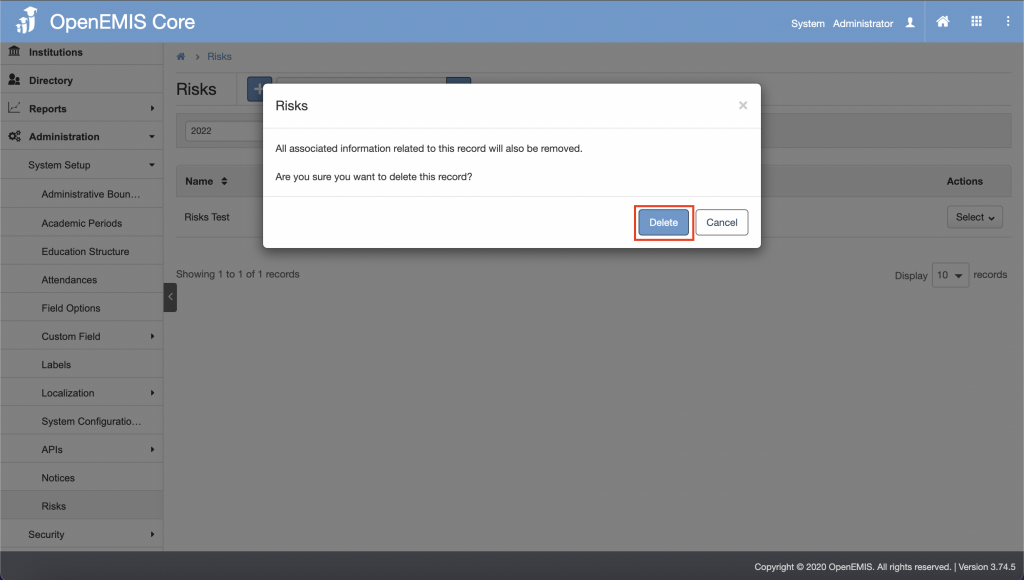
3) The system will display a confirmation prompt to delete the Risks Record.
4) Select ‘Delete’.
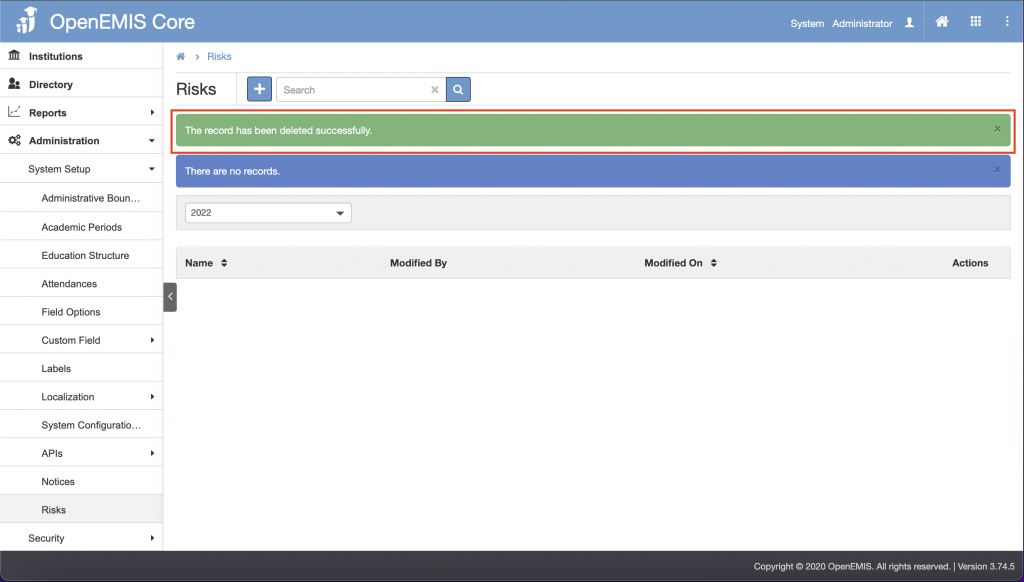
5) System will show a successful message, once record has been deleted.
6) System will remove all the Risks of the Students related to the Risk Record.
Managing Behaviour Classifications
Create Behaviour Classifications
1) Go to Administration > System Setup > Field Options > Behaviour Classifications
2) Select ‘Add’ button
3) Enter the necessary fields.
4) Select Save.
5) System will display a successful message and you may choose to re-order the Behaviour Classifications which will display accordingly in the drop-down list when creating a new Student Behaviour Classifications.
Edit Behaviour Classifications
1) Go to Administration > System Setup > Field Options > Behaviour Classifications
2) Go to Action Bar > Edit
3) Edit the necessary fields.
4) Select Save.
5) Upon saving, System will display a successful message.
View Behaviour Classifications
1) Go to Administration > System Setup > Field Options > Behaviour Classifications
2) Go to Action Bar > View
3) You will be able to view details of the Behaviour Classifications Item.
4) Similarly, you can edit or delete the item in the page.
Delete Behavior Classifications
1) Go to Administration > System Setup > Field Options > Behaviour Classifications
2) Go to Action Bar > Delete
3) The system will display the associated records linked to the Item.
4) Select ‘Save’.
Managing Student Behaviour Categories
Create Student Behaviour Categories
1) Go to Administration > System Setup > Field Options > Student Behaviour Categories
2) Select ‘Add’ button
3) Enter the Required fields
4) Select Save.
5) System will display a successful message and you may choose to re-order the Student Behavior Categories which will display accordingly in the drop-down list when creating a new Risks.
Edit Student Behavior Categories
1) Go to Administration > System Setup > Field Options > Student Behaviour Categories
2) Go to Action Bar > Edit
3) You will able to edit all the fields of the item.
4) Select Save.
5) Upon saving, System will display a successful message.
View Student Behaviour Categories
1) Go to Administration > System Setup > Field Options > Student Behaviour Categories
2) Go to Action Bar > View
3) You will be able to view details of the Student Behaviour Categories Item.
4) Similarly, you can edit or delete the item in the page.
Delete Student Behavior Categories
1) Go to Administration > System Setup > Field Options > Student Behavior Categories
2) Go to Action Bar > Delete
3) The system will display the associated records linked to the Item.
4) Select ‘Save’.
Student Behaviour
Add Student Behaviour
1) Go to Institution > Behaviour > Students
2) Select Add icon.
3) Enter all the required fields.
4) Select Save.
5) System will display a successful message once the record has been added successfully.
Staff Behaviour
Add Staff Behaviour
1) Go to Institution > Behaviour > Staff
2) Select Add icon.
3) Fill in the necessary fields.
4) Select Save.
5) System will display a successful message once the record has been added successfully.
Student Risks
Generate Student Risks
1) Go to Institution > Risks
2) You will be able to see the list of all Risks which contains Number of Risk Index.
3) If you view the risk record, you will see an empty list.
4) Go to Action Bar > Generate, status will then be changed to Processing.
5) If you view the risks record, you will be able to see the list of students that hit the threshold value of the Criteria. User will be able to filter by the Classes, and sort by the name or Total Risks.
6) You will be able to view individual student risk, by selecting on the student record.
7) You will be able to see a detailed information of the Student, the References will allow you to understand on the reason for the Risks.
View Individual Student Risks
1) Go to Institution > Students
2) You will be able to see the list of all Students > select Student
3) Go to Academic > Risks tab.
4) You will be able to view the Total Index of the Student.
5) If you select on the Record, you will be able to see additional details of the Risk.
6) E.g. If you mouse over to the References Info icon, there will be a information box stating the reason of the Risk.

